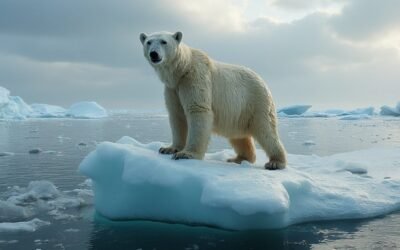You're seeing significant effects of climate change on northern marine life. Rising ocean temperatures are shifting fish distributions and modifying marine ecosystems, causing cold-water species to struggle for survival. Melting sea ice is not only reshaping habitats but also affecting marine mammals whose lives depend on ice. Additionally, increased carbon dioxide levels are leading to ocean acidification, harmful to shellfish and coral reefs, disrupting the balance of marine ecosystems. As warm-water species move north, the biodiversity is changing, affecting food webs and resource management. Understanding these impacts further could reveal critical strategies for adaptation and conservation.
Main Points
- Rising ocean temperatures are shifting marine species distributions, pushing cold-water species north.
- Melting sea ice threatens Arctic marine mammals by altering habitats and feeding grounds.
- Ocean acidification, caused by increased CO2 levels, is damaging to shellfish and coral reefs, disrupting ecosystems.
- Warm-water species are encroaching on northern regions, displacing native cold-water organisms.
- Changes in marine biodiversity due to climate change affect the marine food web and resource management.
Rising Ocean Temperatures
Ocean temperatures in the northern regions are increasing rapidly, dramatically altering marine life and ecosystems. You're witnessing a world where the warming waters are causing fundamental changes—distribution shifts, behavior modifications, and alteration of migration patterns that together signal a profound transformation in these aquatic environments.
As a result, the habitats of many marine species are evolving. Cold-water species, in particular, are facing severe challenges as their preferred cool conditions become scarce. They're either forced to migrate to colder waters or struggle with survival, hinting at the broader climate change impacts reshaping the northern oceans. This shift isn't just about a few species; it's about the disruption of entire ecosystems that depend on these organisms.
Moreover, the behavior changes in marine life due to warmer ocean temperatures are complex. Traditional feeding grounds are no longer reliable, breeding times are shifting, and new competitors are moving into these northern waters. All these factors contribute to a dynamic, yet uncertain future for marine ecosystems here.
Understanding these changes is vital. They're not isolated events but interconnected phenomena that affect biodiversity and the health of the oceans globally. As ocean temperatures continue to rise, these effects will only become more pronounced, challenging the resilience of marine life in the northern regions.
Melting Sea Ice Impact
While rising ocean temperatures reshape marine ecosystems, the melting sea ice further jeopardizes the survival of Arctic species. You're witnessing a significant transformation in the Arctic, where the retreat of sea ice is dramatically altering the habitat and feeding grounds of marine mammals such as polar bears, seals, and walruses. These changes challenge their ability to find food, mate, and rear their young in familiar environments.
As sea ice diminishes, the Earth's albedo decreases, exacerbating climate change by absorbing more solar energy rather than reflecting it back into space. This feedback loop accelerates warming and leads to even more sea ice loss. Consequently, the distribution of species across the Arctic is shifting, disrupting established marine food webs and affecting the overall health of the ecosystem.
The thinning ice also complicates the lives of marine mammals. It's harder for them to access essential breathing holes and rest platforms, which are critical for their survival, especially in harsh Arctic conditions. You're seeing a direct impact on the survival rates of these species, as their environment no longer supports their traditional ways of living. This ongoing change threatens not just individual species but the entire marine ecosystem in the Arctic.
Ocean Acidification Effects
You're facing a critical issue as increased carbon dioxide levels lead to ocean acidification, reducing the availability of carbonate ions necessary for many marine organisms to construct their shells and skeletons. This drop in pH levels is particularly harmful to shellfish such as oysters, clams, and mussels, which find it increasingly difficult to maintain their calcareous defenses. This not only affects their survival but also impacts broader marine life by disrupting ecosystem balance.
Coral reefs, the rainforests of the sea, are also under threat. Acidic waters impair coral calcification, leading to fragile reef structures. As these reefs weaken, the biodiversity they support dwindles, affecting numerous species that rely on them for habitat and food sources. Additionally, the shift in ocean chemistry can alter the reproductive success of various marine species, complicating population dynamics and potentially leading to drastic shifts in marine ecosystems.
To combat these challenges, conservation efforts and adaptation strategies are essential. Monitoring pH levels helps gauge the severity of acidification and guides interventions. By understanding these impacts, you can support initiatives aimed at mitigating acidification and promoting the resilience of marine environments.
Changing Fish Distribution
As climate conditions evolve, marine species are migrating poleward at an alarming rate of about 44 miles per decade. This shift is redefining fish distributions and the overall dynamics of marine ecosystems. You're seeing warm-water organisms venture further north than ever before, as fewer cold events make these regions more hospitable. Conversely, cold-water species are being edged out, finding their traditional habitats increasingly unsuitable.
The repercussions of these shifts go beyond individual species. They're reshaping marine life as a whole and pose significant challenges for natural resource management. With marine species shifting poleward, there's a cascading effect on the food web and interactions within marine ecosystems. As you look at the broader picture, it's clear that climate change impacts are deeply interwoven with the life and survival of myriad marine organisms.
Understanding and adapting to these changes is critical. Effective management strategies must consider the new realities of fish distributions and the ongoing shifts within marine ecosystems. This isn't just about preserving what's left; it's about foreseeing and responding to changes that are reshaping the marine world. You're at a pivotal point in addressing how climate change impacts the future of marine life and its sustainability.
Threats to Marine Biodiversity
Climate change is drastically altering marine biodiversity in northern regions as cold-water species retreat and warm-water species advance northward. The shifts in cold event frequency are reshaping the distributions and migrations of these marine organisms, creating a new dynamic in the ecosystem. You're seeing warm-water species thrive in areas where they've never been, as the decreased cold events make these regions more hospitable.
This migration isn't just a change in scenery; it's affecting the very fabric of marine biodiversity. As cold-water species leave their traditional habitats, they're struggling to find new homes where conditions are suitable, and some are failing to adapt. This loss of species not only affects the marine food web but also poses challenges for you, the natural resource managers, who must now adapt management strategies to these new realities.
Moreover, the impacts of extreme climatic events are becoming more critical to understand. As these events increase in frequency, intensity, and duration, they further complicate the lives of marine organisms. It's essential for you to grasp these changes thoroughly to mitigate negative effects on marine biodiversity and secure the sustainability of marine life in northern regions.
Indigenous Communities' Challenges
Facing mounting challenges, Indigenous communities reliant on marine resources are grappling with the impacts of changing fish stocks and habitats due to climate change. These shifts are affecting traditional fishing practices, essential for both the cultural well-being and food security of these groups. As fish distributions and abundance alter, you're forced to rethink how and where to fish, disrupting centuries-old traditions that have long sustained your communities.
Rising sea levels and ocean acidification pose further threats, not only to the marine environment but to your very homes and the economic stability of coastal communities. The loss of marine biodiversity and disruptions in ecosystem dynamics are hitting you hard, impacting daily livelihoods and long-term economic challenges.
Fortunately, your deep-rooted Indigenous knowledge serves as a critical foundation for developing effective adaptation strategies. You're utilizing this wisdom to better understand and react to the changing conditions, employing innovative approaches to manage and preserve marine resources. This knowledge, combined with new scientific insights, is key to sustaining your way of life and ensuring the resilience of your communities against the ongoing threats posed by climate change.
Frequently Asked Questions
How Does Climate Change Affect the Marine Life?
As you're exploring the impacts of climate change on marine life, you'll find that it triggers coral bleaching, exacerbates ocean acidification, and prompts habitat shifts. These changes lead to algal blooms, species migration, and thermal stress, affecting reproductive patterns and disrupting food webs.
Additionally, climate change facilitates the spread of invasive species and magnifies pollution impacts, complicating the survival and adaptation of marine species in their evolving environments.
How Are Marine Fish Affected by Climate Change?
You're witnessing marine fish grappling with climate change as temperature shifts alter their migration patterns and breeding disruptions become common.
Warmer waters and ocean acidification lead to habitat loss and food scarcity, impacting predator-prey dynamics. Altered ecosystems force fish into genetic adaptations and increase disease prevalence.
Such changes not only challenge the fish but ripple through the food chain, affecting fisheries and, ultimately, global food security.
How Does the Ocean Affect Northern Climates?
The ocean plays a crucial role in influencing northern climates through its circulation patterns, which distribute heat and impact Arctic temperature shifts.
Oceanic changes like polar ice melting and sea level rise contribute to coastal erosion dynamics and saltwater intrusion.
Moreover, the ocean's ability to absorb carbon affects atmospheric conditions, while changes in albedo effect and storm frequency can alter weather patterns.
These factors collectively shape the climate and environmental stability of northern regions.
What Is a Major Impact of Climate Change on Fish Species?
Imagine fish as nomads of the sea, constantly moving to find comfort and sustenance. Due to climate change, you're seeing major impacts like altered migratory patterns and breeding disruptions.
Temperature fluctuations and acidification are reshaping their world, leading to food scarcity, habitat loss, and coral bleaching. These changes challenge their survival, affecting metabolic rates and even causing genetic alterations.
It's a tough journey for these marine creatures, shaping the future of aquatic life.
How Is Climate Change Impacting the Best Fish Species in the Northern Ocean?
Climate change is drastically altering marine ecosystems, especially by warming waters and reducing oxygen levels, which directly affect the best fish species northern ocean. These species are pushed to migrate toward cooler waters, disrupting food chains and traditional fishing grounds, threatening their survival and the livelihoods of local communities.
Conclusion
As you navigate through the shifting landscape of northern marine ecosystems, imagine the ocean's health dangling like a delicate thermometer, sensitive to every fluctuation. Rising temperatures, melting ice, and increasing acidity undermine the fabric of marine life, altering fish distributions and threatening biodiversity.
These changes pose significant challenges for indigenous communities reliant on these waters. It's imperative to understand and address these impacts, ensuring the sustainability of both marine life and the cultures intertwined with it.


